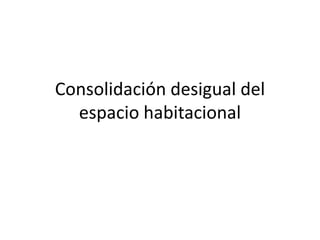Consolidación desigual del espacio habitacional
•Télécharger en tant que PPTX, PDF•
0 j'aime•467 vues
Signaler
Partager
Signaler
Partager

Recommandé
Recommandé
Contenu connexe
En vedette
En vedette (20)
Product Design Trends in 2024 | Teenage Engineerings

Product Design Trends in 2024 | Teenage Engineerings
How Race, Age and Gender Shape Attitudes Towards Mental Health

How Race, Age and Gender Shape Attitudes Towards Mental Health
AI Trends in Creative Operations 2024 by Artwork Flow.pdf

AI Trends in Creative Operations 2024 by Artwork Flow.pdf
Content Methodology: A Best Practices Report (Webinar)

Content Methodology: A Best Practices Report (Webinar)
How to Prepare For a Successful Job Search for 2024

How to Prepare For a Successful Job Search for 2024
Social Media Marketing Trends 2024 // The Global Indie Insights

Social Media Marketing Trends 2024 // The Global Indie Insights
Trends In Paid Search: Navigating The Digital Landscape In 2024

Trends In Paid Search: Navigating The Digital Landscape In 2024
5 Public speaking tips from TED - Visualized summary

5 Public speaking tips from TED - Visualized summary
Google's Just Not That Into You: Understanding Core Updates & Search Intent

Google's Just Not That Into You: Understanding Core Updates & Search Intent
The six step guide to practical project management

The six step guide to practical project management
Beginners Guide to TikTok for Search - Rachel Pearson - We are Tilt __ Bright...

Beginners Guide to TikTok for Search - Rachel Pearson - We are Tilt __ Bright...
Unlocking the Power of ChatGPT and AI in Testing - A Real-World Look, present...

Unlocking the Power of ChatGPT and AI in Testing - A Real-World Look, present...
Consolidación desigual del espacio habitacional
- 1. Consolidación desigual del espacio habitacional
- 2. Caracterización del D.U. • Centro histórico • Pueblo conurbado • Colonia popular • Conjunto habitacional • Colonia residencial de nivel medio • Colonia residencial de nivel alto
- 3. Condiciones habitacionales. • Escala : ZMVM • Tiempo: 1950-1990 • Objeto de estudio: Las viviendas
- 5. Espacio habitable • Se redujo la densidad domiciliaria (hab/viv) – Número de habitantes por cuarto (-) – Diferencias entre tipos de poblamientos. – 3.8 C.Resid y 5.2 Pueb. conurbados y col. populares. (1990). • Grado de consolidación. – Ampliación de construcción cuartos y usos.
- 7. Calidad de Materiales • El material de los techos y recubrimientos en los pisos (2 indicadores diferenciación de poblamiento). – “Debido al atraso acumulado, en los municipios conurbados el logro ha sido más evidente, pues ahí el porcentaje de viviendas con techo de losa se incrementó de 59% en 1970 a 74% en 1990”.
- 9. Servicios Sanitarios • servicios sanitarios básicos (agua potable y drenaje) – Dificultades financieras – Agua entuba de 61.5% en 1980 a 54.0% en 1990 (num. conurbado el Edo. de México) • Fuentes alejadas, superficiales (40´s), subterraneas, dentro y fuera de la cuenca (50´s),
- 10. • “El consumo promedio per cápita muestra las diferencias metropolitanas: 198 litros/hab/día para los habitantes de los municipios conurbados frente a 303 que reciben los residentes del Distrito Federal.” • El precio pagado bimestralmente en 1988 por consumo hasta de 50 m3 para el Distrito Federal era de 1 116 pesos y para el Estado de México 8 415 pesos.
- 12. Un doble patrón espacial del espacio metropolitano. • La evidencia confirma opiniones en el sentido de que la consolidación de la ZMCM ha sido un proceso sumamente diferenciado: más heterogéneo (con mayor mezcla social) en las zonas centrales y más homogéneo (con mayor segregación de los pobres) en la periferia.
